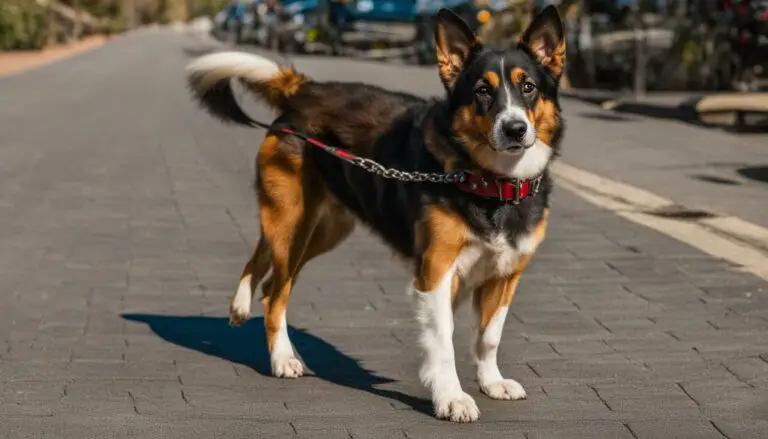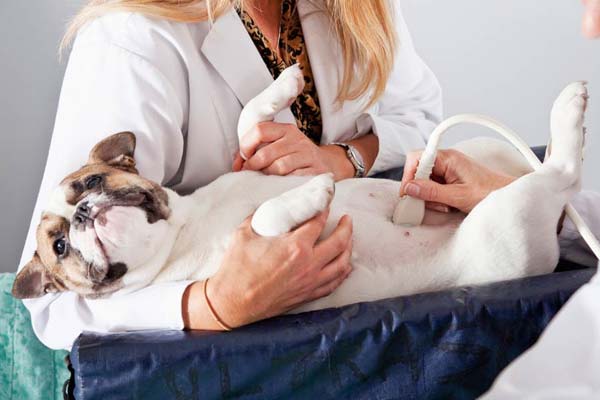What to Expect When Your Dog is Expecting
The birth of new puppies is an exciting time for your family. To ensure that your dog has a healthy pregnancy and birth, you need to understand the female reproductive, the gestation and labor stages, and how to care for your dog.
What Are the Stages of the Female Reproductive Cycle?
There are four stages of the female reproductive cycle. Knowing these stages can be helpful in deciding when to breed your dog.
Female dogs go into heat about every six months and the heat cycle continues for 18 to 21 days.
The first stage lasts approximately nine days and is called proestrus. Females will begin to have a bloody discharge and swollen vulva but will usually reject males during this stage.
The second stage is called estrus and lasts from 3 to 11 days. There will be less discharge and it will be lighter in color. The vulva is enlarged and becomes softer. Females will look to mate with males, so this stage is when pregnancy is most likely to happen.
The third stage, diestrus, is when the female’s discharge becomes darker and begins to lessen as she approaches the end of her cycle. The swelling in the vulva subsides, and she will again reject males. The female is no longer in heat when the discharge is finished.
The final stage of the reproductive cycle is called anestrus. It is the approximately six-month period before the dog again comes into heat.
How Can You Tell if Your Dog Is Pregnant?
There are four tests that veterinarians can perform to determine if your dog is pregnant. The AKC advises that you let your vet know exactly when your dog was bred because the pregnancy tests are time sensitive.
The four pregnancy tests are:
- An ultrasound is the earliest way to determine if your dog is pregnant and can be done as early as 25 days into the pregnancy. An ultrasound can detect fetal heartbeats and also rule out any other conditions that would result in a distended uterus.
- Your vet can test your dog for relaxin, a hormone that is present only during pregnancy. The dog must be at least 30 days into the gestation period for the test to be accurate.
- Palpation, which is using the hands to feel your dog’s belly, can be used to feel for signs of pregnancy. Palpation is best done during the third to the fourth week into the gestation.
- X-rays are an effective way to determine how many puppies are in the litter. The AKC states that waiting until after day 55 into the pregnancy gives the most accurate count of the number of puppies and is best for determining if a cesarean delivery is needed.
Perhaps you are not trying to breed your dog but suspect that she may have become pregnant.
Some of the signs you can look for include:
- An increase or decrease in appetite or cravings for a particular snack or treat. Central Park Paws states that the increase in appetite or cravings can occur quickly, but a loss of appetite may not occur for about two weeks.
- A pregnant dog may suddenly need a lot of attention or she may not want any interaction with you at all. Look for any behavior that is not normal for your dog. She may also become more tired.
- One of the earliest signs of pregnancy will be a change in your dog’s nipples. The will begin to enlarge, become a darker pink color, and by the second week, you will be able to see breast enlargement.
Dog Time recommends that you have your dog checked by your vet if you notice any of these symptoms so that you can rule out other medical conditions.
How Long Are Dogs Pregnant? Gestation Period
The gestation period for a dog is about 63 days or nine weeks. There are three stages to the gestation period and each one lasts about 21 days.
The first stage is when the fetuses form in the uterus. The embryos travel through the uterine horn about seven days after impregnation and they embed in the uterine lining at about 16 days.
The fetuses begin to form at about day 22, and their heartbeats should be detectable by ultrasound between day 28 and 30.
A vet should also be able to feel the puppies in your dog’s belly at this stage. Rover warns that you should not try to feel the puppies on your own because you could cause a miscarriage or harm the fetuses.
During this stage, your dog will probably have an increase in appetite and a decrease in physical activity. Her nipples will start to enlarge and near the end of stage one, she will have a clear vaginal discharge.
The second stage of pregnancy is when the fetuses complete most of their development. The eyelids appear around day 32, the toes around day 35, the claws around day 40 and the coat and skeleton around day 45.
Your dog will have a large, firm abdomen by day 45 and you should be able to see the puppies moving by about day 50.
During the second stage, your dog will have gained weight and you may notice behavioral changes. She will continue to have a clear vaginal discharge and will probably be urinating more frequently. Her appetite will begin to decrease around day 45.
The third pregnancy stage begins around day 58 when the puppies begin to move into the birth canal or the whelping position.
During this stage, your dog probably not have much of an appetite. She may appear restless and you may notice her pacing or panting.
Her body temperature will drop in the 12 to 24 hours before she goes into labor.
Your dog will begin looking for a place to nest during the final stages of pregnancy, and Dogster recommends that you prepare a comfortable place for her as she gets ready for labor and delivery.
How Long Are Dogs in Labor?
How long a dog is in labor varies depending on the number of puppies in the litter. There are three stages of labor.
The first stage usually lasts between 12 and 24 hours. Your dog will be having contractions during this stage, but the contractions will probably not be visible. The AKC suggests that you look for signs such as nesting, restlessness, panting, wanting to be alone and refusing to eat.
The second stage is when the puppies are delivered, and this can take as long as 24 hours. Puppies have birthed one at a time and usually 30 to 60 minutes apart, although it can take from one to two hours for a puppy to be delivered.
Rover recommends that you be prepared to assist your dog if a puppy is sideways or backward during birth.
The third stage of labor is delivery of the placentas. This begins occurring during stage two and is finished after all the placentas have passed. It does not take long after the birth of the last puppy for stage three to be completed.
It is natural for your dog to eat some of the placentas, but you should try to get these and dispose of them in the garbage.
If your dog is in labor for more than 24 hours or if more than two hours pass between the birth of puppies, there could be a complication. You should contact your vet immediately.
If possible, try to get your dog to go outside to empty her bladder after all the puppies are born. Her natural instinct will be to stay with her puppies so don’t force her to go out if she doesn’t want to go right away.
What Medical Care Does a Pregnant Dog Need?
It is important to keep all immunizations and medications such as flea, tick and heartworm current. Central Park Paws also advises that you give your pregnant dog deworming medication and suggests a schedule beginning at four weeks of pregnancy and continuing every week until birth.
After birth, your dog should continue deworming medication while she is still nursing the puppies, generally until eight weeks after birth.
Make sure that the deworming medication you use is safe for lactating dogs and the puppies. The puppies will also receive deworming medication for these eight weeks.
This YouTube video gives a good overview of caring for your dog before, during and after pregnancy.
What Should You Feed a Pregnant Dog?
As long as your dog’s regular food is a well-balanced formula, it is ok to feed the same diet during the first half of the pregnancy.
During the second half of the pregnancy, you should switch her to a puppy food that is high in fatty acids as these help with brain development. A good ingredient to look for is fish oil. Puppy food will contain all the proper nutrition that the puppies need.
Consider feeding your dog smaller but more frequent meals. She will have less room for food because of the growing puppies.
Is Exercise Important for a Pregnant Dog?
A healthy dog will have an easier and less painful labor and delivery. You should take your pregnant dog on several short walks daily, but don’t force her to go if she doesn’t want to walk. The walks should be shorter as she gets closer to the delivery date.
You should also try to minimize her stress during the pregnancy. Central Park Paws recommends changing your walking schedule to avoid other dogs, especially those that bark excessively or that may otherwise stress or over-excite your dog.
What Should You Do to Prepare for the Birth of the Puppies?
You need to prepare a whelping box where your dog will give birth. You can corner off an area in a room, use a plastic kids pool, or a spare bathroom or closet.
If you use a spare bathroom or closet, be sure to put something across the doorway that is high enough to keep the puppies in but low enough for your dog to easily get in and out.>
You need to have several towels and blankets to line the bottom of the whelping box and for cleaning up as the puppies are born.
Some of these will have to be discarded after birth, but the rest can be cleaned and reused while the puppies are still in the whelping box. Just make sure that you do not use any bleach when washing them.
What Care Does Your Dog Need After She Gives Birth
Talk with your veterinarian on the first day after your dog gives birth. Your vet can discuss proper after-birth care and answer any questions you may have.
Your dog will be nursing her puppies for several weeks to feed her a good quality puppy food. She needs to have as much food as she wants while nursing and then you can taper down to her regular amount of food once the puppies are weaned.
Your dog will be drinking more water than usual, and the water bowl will be dirtier because she is cleaning the puppies. Make sure you change out the water several times a day, so she always has fresh water.
Caring for and nursing the puppies can take all of your dog’s energy. Central Park Paws recommends that after the first two weeks you put a bed next to the whelping box. This will allow your dog to rest while still being near her puppies.
In addition to nutrition and rest, you need to check that there is no injury to your dog’s nipples and watch her post-birth discharge.
The discharge will vary in color, and it may take up to two weeks before it stops. Call your veterinarian if the discharge continues for more than two weeks or is black in color.
Conclusion
Proper care before, during and after pregnancy is crucial for both your dog and her puppies. Regular checkups with your vet will ensure that your dog is staying healthy and the puppies are developing normally.






